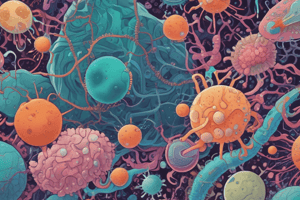Podcast
Questions and Answers
Match the following branches of microbiology with their corresponding fields of study:
Match the following branches of microbiology with their corresponding fields of study:
Bacteriology = Studi tentang virus Virology = Studi tentang fungi Mycology = Studi tentang bakteri Parasitology = Studi tentang parasit
Match the following characteristics of microorganisms with their descriptions:
Match the following characteristics of microorganisms with their descriptions:
Prokaryotic = Memiliki inti sejati Eukaryotic = Tidak memiliki inti sejati Autotrophic = Menghasilkan makanan sendiri Heterotrophic = Mendapatkan makanan dari sumber luar
Match the following types of microbial growth with their environmental conditions:
Match the following types of microbial growth with their environmental conditions:
Aerobic = Tanpa oksigen Anaerobic = Dengan oksigen Fermentation = Menghasilkan energi dari glukosa Photosynthesis = Menghasilkan makanan dari cahaya
Match the following types of symbiotic relationships with their descriptions:
Match the following types of symbiotic relationships with their descriptions:
Match the following roles of microorganisms in the environment with their descriptions:
Match the following roles of microorganisms in the environment with their descriptions:
Match the following types of microbial nutrition with their descriptions:
Match the following types of microbial nutrition with their descriptions:
Study Notes
Microbiology in Bacteriology
Definition and Scope
- Microbiology: the study of microorganisms, including bacteria, viruses, fungi, and protozoa
- Includes the study of microbial structure, function, growth, and interactions with the environment and hosts
Branches of Microbiology
- Bacteriology: study of bacteria
- Virology: study of viruses
- Mycology: study of fungi
- Parasitology: study of parasites
- Microbial Ecology: study of microbial interactions with the environment
Microbial Characteristics
- Microbes are microscopic, typically ranging from 0.5-5.0 μm in size
- Microbes can be prokaryotic (lacking a true nucleus) or eukaryotic (having a true nucleus)
- Microbes can be autotrophic (produce own food) or heterotrophic (obtain food from external sources)
Microbial Growth and Nutrition
- Microbes can grow in various environments, including aerobic (with oxygen) and anaerobic (without oxygen) conditions
- Microbes can obtain nutrients through fermentation, respiration, or photosynthesis
- Nutrient sources include organic compounds, inorganic compounds, and other microorganisms
Microbial Interactions and Relationships
- Symbiotic relationships: mutualism (benefits both organisms), commensalism (benefits one organism), and parasitism (harms one organism)
- Microbes can form biofilms, complex communities attached to surfaces
- Microbes play key roles in decomposition, nutrient cycling, and human health and disease
Mikrobiologi dalam Bakteriologi
Definisi dan Ruang Lingkup
- Mikrobiologi: studi tentang mikroorganisme, termasuk bakteri, virus, fungi, dan protozoa
- Termasuk studi tentang struktur, fungsi, pertumbuhan, dan interaksi dengan lingkungan dan inang
Cabang-cabang Mikrobiologi
- Bakteriologi: studi tentang bakteri
- Virologi: studi tentang virus
- Mikologi: studi tentang fungi
- Parasitologi: studi tentang parasit
- Ekologi Mikroba: studi tentang interaksi mikroba dengan lingkungan
Karakteristik Mikroba
- Mikroba bersifat mikroskopis, biasanya berukuran 0,5-5,0 μm
- Mikroba dapat berupa prokariotik (tidak memiliki inti sejati) atau eukariotik (memiliki inti sejati)
- Mikroba dapat bersifat autotrofik (menghasilkan makanan sendiri) atau heterotrofik (mendapatkan makanan dari sumber eksternal)
Pertumbuhan dan Nutrisi Mikroba
- Mikroba dapat tumbuh dalam berbagai kondisi lingkungan, termasuk aerobik (dengan oksigen) dan anaerobik (tanpa oksigen)
- Mikroba dapat memperoleh nutrisi melalui fermentasi, respirasi, atau fotosintesis
- Sumber nutrisi termasuk senyawa organik, senyawa anorganik, dan mikroba lainnya
Interaksi dan Hubungan Mikroba
- Hubungan simbiotik: mutualisme (menguntungkan kedua organisme), komensalisme (menguntungkan salah satu organisme), dan parasitisme (merugikan salah satu organisme)
- Mikroba dapat membentuk biofilm, komunitas kompleks yang melekat pada permukaan
- Mikroba memainkan peran penting dalam dekomposisi, siklus nutrien, serta kesehatan dan penyakit manusia
Studying That Suits You
Use AI to generate personalized quizzes and flashcards to suit your learning preferences.
Description
Test your knowledge of microbiology, including the study of bacteria, viruses, fungi, and protozoa, as well as their interactions with the environment and hosts.




